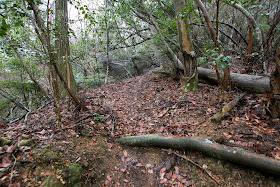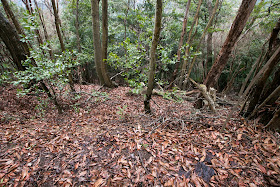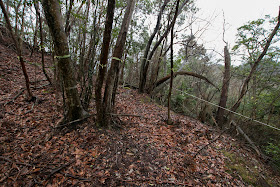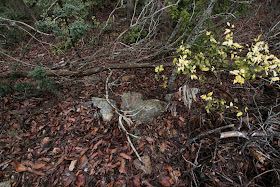Warouji Castle
-Time to treason (8) various battles around Kinki region-
Overview
Name: Warouji castle (Warouji-jo)
Alias:
Place: Warouji Nishi-Betsuin-cho Kameoka city, Kyoto
Location: 34.97013164241476, 135.5196432042123
Type: Mountain Castle
Built: 14th century?
Remaining remnants: Stone walls, clay walls and dry moats
Title:
Continued from Part 7
Warouji castle (笑路城) is built over Matsuo-yama hill, one of about 100 meter height from hillside at the northeast of Warouji settlements. Castle site exists in the north part of Hokusetsu mountains which geographically separate Kameoka basin and Osaka plain, and also just at the side of administrative border of Kyoto prefecture and Osaka prefecture.
Warouji area is a diverging point of Setsutan Kaido road which straightly connects Kameoka area and Minomo area north and southward currently used as Route 423, and an orthogonal road toward Myokensan mountain which is an important religious place or Nose-Kaido road. Because of its location it had been an important border castle of Tanba province (western part of Kyoto prefecture) toward Settsu province (north part of Osaka prefecture and east part of Hyogo prefecture).
Precise year is unknown but Warouji castle might be built by local lord Nagasawa clan by 15th century. The origin of Nagasawa clan is also unclear but it might be originally a samurai in eastern Japan and followed to Yoritomo Minamoto (1147-1199), the founder of Kamakura Shogunate then was appointed as the lord of the manor of Betsuin area including Warouji village.
During Muromachi era, as Tanba province was just the next of capital Kyoto city, Nagasawa clan directly served to Muromachi Shogunate and became its administrative staff. But Muromachi Shogunate lost their power and authority after the battle of Onin occurred at Kyoto city from 1467 to 1477, thus Nagasawa clan belonged to Naito clan, the deputy governor of Tanba province which was the lord of Yagi castle (Kyoto prefecture)..
In the middle part of 16th century, there arouse conflict between Naito clan and other local lord of the province such as Hatano clan of Yagami castle (Hyogo prefecture) or Akai clan of Kuroi castle (Hyogo prefecture). Once Naito clan subdued Hatano clan under the support of their master Miyoshi clan.
However, along with the decline of Miyoshi clan, Hatano clan or Akai clan came to leave Naito clan and challenge. Naito clan tried to suppress Akai clan but suffered severe defeat and lost their leader Nagayori Naito (?-1565) before Akai clan in 1565. But Naito clan barely survived at Kameoka basin thus Nagasawa clan kept following to Naito clan.
In 1568, Nobunaga Oda (1534-1582), the warlord of Owari province (western half of Aichi prefecture), marched to Kyoto city and built his own government placing Yoshiaki Ashikaga (1537-1597) as the 15th Shogun of Shogunate. But soon Nobunaga and Yoshiaki broke and became hostile for the power of government.
At first local lords of Tanba province including Nagasawa clan followed to Yoshiaki and Nobunaga, but after their break most local lords belonged to Yoshiaki based on their tradition. Nobunaga had to cope with threat at eastern border such as Asakura clan or Takeda clan once let Tanba province untouched.
In 1575, after the stabilization of its eastern front, Nobunaga order his general Mitsuhide Akechi (1528-1582) to ruin opponent local lords and capture Tanba province. At first Mitsuhide agreed with Hatano clan then directly marched to Akai clan at the inside of the province, but facing betrayal of Hatano clan, Akechi army was defeated then Mitsuhide once retreated from the province.
For his second attack, Mitsuhide took more careful strategy capturing castles one by one from frontline. Mitsuhide built Tanba Kameyama castle (Kyoto prefecture) as his front base at Kameyama basin, and tried to seize whole part of Kameyama basin.
Nagasawa clan once resisted against Mitsuhide, but under coordination of Sakai clan of Hokiyama castle just the next of Warouji castle and already followed to Mitsuhide coordinated facing two army at “Akechi Modori-Iwa” (Akechi returning rock) at Hoki pass, then Nagasawa clan became the retainer of Akechi clan.
At this time, Settsu province ahead of the border was still unstable as Ikko Ikki army still resisted against Nobunaga at Ishiyama Honganji Temple (current Osaka castle). Local lords of Settsu province once followed to Nobunaga but their attitude was unstable and there was expectation of reinforcement army from Mouri clan toward Honganji Temple. Thus Mitsuhide reformed Warouji castle as border castle and front base toward Settsu province.
Warouji castle spreads over slightly curved ridge of Matsuo-yama mountain. Central area of the castle is a rectangular one of about 40 meter long and 30 meter wide at the middle of the castle, which might have stone wall at its eastern and southern line. According to excavation, there found the line of stone wall and basement of turret between central area and western area.
At the west of central area, there is another large area partially remaining broken stone walls. As this side directly faces the village and road, this part might be front side of the castle and has large masugata style gate, which is directly protected by the turret of central area. Below of western area, there are two terraces which has clay wall toward slope.
At the east of central area, there are two areas in a linear and huge dry moat which separate the castle from backside peak. Eastern edge of the lower area faces dry moat is a defense point surrounded by clay wall, and there are the ruins of two gates guarded by low height stone wall. Total size of the castle is about 150 meter long and not so large but well protected by stone walls and shows the importance of the castle.
At the same time of his second attack to Tanba province, Mitsuhide was involved in various operations in Kinki region. Mitsuhide had plenty of musket gunners in his army with excellent tactics, and Nobunaga who could stabilize eastern front now concentrate to the capture of Kinki region, to keep capital Kyoto city.
In 1576, when encircling Ikko Ikki army besieged at Ishiyama Honganji temple, Oda army faced sudden attack of the gunners of Saika army belonged to Ikko Ikki army thus Naomasa Ban (?-1576), the highest commander of Oda army at the battle, died in the combat. Mitsuhide stayed at Tennoji fort was encircled by thousands of enemies and fell in desperate situation.
In response to the request from Mitsuhide, Nobunaga rushed to the battlefield only with his guards and assaulted the enemy then entered into Tennoji fort but injured. Next Nobunaga and Mitsuhide again charged into superior enemy and gave severe damage to the enemy.
Honganji army lost their attack force turned to defensive, then its threat to Oda army significantly declined. But Mitsuhide tired continuous battles after the defeat at Tanba province once fell into severe ill, and also lost his wife Hiroko Akechi (?-1576) survived poor youth period together in ill.
Next year in 1577, looking at the defeat of Oda army before Kenshin Uesugi (1530-1578), the warlord of Echigo province (Niigata prefecture) at the battle of Tedorigawa, Hisahide Matsunaga (1508-1577), the general of Oda army good at plots, betrayed Nobunaga and raised army at his main base Shigisan castle (Nara prefecture). Mitsuhide were sent to encircle Shigisan castle along with other major generals and finally fell Shigisan castle.
In 1578, Mouri clan which was the large warlord of Chugoku region sent large army to Harima province. Hideyoshi Hashiba (1537-1598, later Hideyoshi Toyotomi) once captured the province but had smaller army than Mouri clan, and Mitsuhide was sent to reinforcement to Hideyoshi. But Hideyoshi finally retreated from border area abandoning Kozuki castle (Hyogo prefecture).
Looking at the offense of Mouri army, Bessho clan which was the major local lord of Miki castle who once followed to Hideyoshi turned to the enemy and raised the army at Miki castle. It was a fatal accident to Hideyoshi, and also to Mitsuhide who faced Hatano clan at Yagami castle, as Miki clan and Hatano clan were marital relative and could cooperate each other.
Furthermore, at the same year, Murashige Araki (1535-1586), one of major general of Oda army and married with the daughter of Mitsuhide, also betrayed and raised army at his main base Arioka castle (Hyogo prefecture). It seemed Mouri army could connect to Honganji temple through Bessho clan and Araki clan then the front of Nobunaga could collapse.
But Hideyoshi and Mitsuhide bear this severe situation and reversed it step by step. Hideyoshi tightly encircled Miki castle and fell it by shortage of supply after two year siege, and Arioka castle also fell after one year siege by Oda army including Akechi army, mainly because Kiyohide Nakagawa (1542-1583) and Ukon Takayama (?-1615), two major general of Araki army turned to Oda army.
Finally in 1579, Ukita clan which was the warlord of Bizen province (southeastern part of Okayama prefecture) once belonged to Mouri clan turned to Hideyoshi, and Mouri clan could not send support to Kinki region any more. Mitsuhide fell Yagami castle and Kuroi castle at that year, and next year Hideyoshi fell Miki castle and Ikko Ikki army opened Ishiyama Honganji temple.
Achievement of Mitsuhide as reinforcement army in Kinki region later pushed Mitsuhide to the regional commander of Kinki region, the most important territory of Oda clan. But this also brought delay of capture of Tanba province and capture of Tajima province (north part of Hyogo prefecture) by Hideyoshi Toyotomi, which later meant disappearance of front line in charge and loss of role of Mitsuhide in Oda clan.
Warouji castle was used as border castle under Nagasawa clan by 1582. But after the revolt of Mitsuhide against Nobunaga in 1582, Mitsuhide was defeated by Hideyoshi Hashiba in the battle of Yamazaki and died after the battle, and leader of Nagasawa clan also died in the battle. Warouji castle was also abolished at that time.
Today no building was left but structure of the castle remains on the mountain with partial remnants of stone wall. Castle area is a quiet village but Route 423 which passes in front of the castle has certain traffic compared with the territory. Line of cars seen from castle site resembles troops of Akechi clan departed toward Settsu province as reinforcement army.
Continue to Part 9
30 minutes walk from Kameoka City Community Bus Warouji Bus stop. 30 minutes drive from Kyoto-Jyukan Jidoshado Expressway Kameoka interchange.
Type: Mountain Castle
Built: 14th century?
Remaining remnants: Stone walls, clay walls and dry moats
Title:
Brief History
Continued from Part 7
Warouji castle (笑路城) is built over Matsuo-yama hill, one of about 100 meter height from hillside at the northeast of Warouji settlements. Castle site exists in the north part of Hokusetsu mountains which geographically separate Kameoka basin and Osaka plain, and also just at the side of administrative border of Kyoto prefecture and Osaka prefecture.
Warouji area is a diverging point of Setsutan Kaido road which straightly connects Kameoka area and Minomo area north and southward currently used as Route 423, and an orthogonal road toward Myokensan mountain which is an important religious place or Nose-Kaido road. Because of its location it had been an important border castle of Tanba province (western part of Kyoto prefecture) toward Settsu province (north part of Osaka prefecture and east part of Hyogo prefecture).
Origin of Warouji castle
Precise year is unknown but Warouji castle might be built by local lord Nagasawa clan by 15th century. The origin of Nagasawa clan is also unclear but it might be originally a samurai in eastern Japan and followed to Yoritomo Minamoto (1147-1199), the founder of Kamakura Shogunate then was appointed as the lord of the manor of Betsuin area including Warouji village.
During Muromachi era, as Tanba province was just the next of capital Kyoto city, Nagasawa clan directly served to Muromachi Shogunate and became its administrative staff. But Muromachi Shogunate lost their power and authority after the battle of Onin occurred at Kyoto city from 1467 to 1477, thus Nagasawa clan belonged to Naito clan, the deputy governor of Tanba province which was the lord of Yagi castle (Kyoto prefecture)..
In the middle part of 16th century, there arouse conflict between Naito clan and other local lord of the province such as Hatano clan of Yagami castle (Hyogo prefecture) or Akai clan of Kuroi castle (Hyogo prefecture). Once Naito clan subdued Hatano clan under the support of their master Miyoshi clan.
Situation of Tanba province
However, along with the decline of Miyoshi clan, Hatano clan or Akai clan came to leave Naito clan and challenge. Naito clan tried to suppress Akai clan but suffered severe defeat and lost their leader Nagayori Naito (?-1565) before Akai clan in 1565. But Naito clan barely survived at Kameoka basin thus Nagasawa clan kept following to Naito clan.
In 1568, Nobunaga Oda (1534-1582), the warlord of Owari province (western half of Aichi prefecture), marched to Kyoto city and built his own government placing Yoshiaki Ashikaga (1537-1597) as the 15th Shogun of Shogunate. But soon Nobunaga and Yoshiaki broke and became hostile for the power of government.
At first local lords of Tanba province including Nagasawa clan followed to Yoshiaki and Nobunaga, but after their break most local lords belonged to Yoshiaki based on their tradition. Nobunaga had to cope with threat at eastern border such as Asakura clan or Takeda clan once let Tanba province untouched.
Entrance of Mitsuhide Akechi
In 1575, after the stabilization of its eastern front, Nobunaga order his general Mitsuhide Akechi (1528-1582) to ruin opponent local lords and capture Tanba province. At first Mitsuhide agreed with Hatano clan then directly marched to Akai clan at the inside of the province, but facing betrayal of Hatano clan, Akechi army was defeated then Mitsuhide once retreated from the province.
For his second attack, Mitsuhide took more careful strategy capturing castles one by one from frontline. Mitsuhide built Tanba Kameyama castle (Kyoto prefecture) as his front base at Kameyama basin, and tried to seize whole part of Kameyama basin.
Nagasawa clan once resisted against Mitsuhide, but under coordination of Sakai clan of Hokiyama castle just the next of Warouji castle and already followed to Mitsuhide coordinated facing two army at “Akechi Modori-Iwa” (Akechi returning rock) at Hoki pass, then Nagasawa clan became the retainer of Akechi clan.
At this time, Settsu province ahead of the border was still unstable as Ikko Ikki army still resisted against Nobunaga at Ishiyama Honganji Temple (current Osaka castle). Local lords of Settsu province once followed to Nobunaga but their attitude was unstable and there was expectation of reinforcement army from Mouri clan toward Honganji Temple. Thus Mitsuhide reformed Warouji castle as border castle and front base toward Settsu province.
Structure of Warouji castle
Warouji castle spreads over slightly curved ridge of Matsuo-yama mountain. Central area of the castle is a rectangular one of about 40 meter long and 30 meter wide at the middle of the castle, which might have stone wall at its eastern and southern line. According to excavation, there found the line of stone wall and basement of turret between central area and western area.
At the west of central area, there is another large area partially remaining broken stone walls. As this side directly faces the village and road, this part might be front side of the castle and has large masugata style gate, which is directly protected by the turret of central area. Below of western area, there are two terraces which has clay wall toward slope.
At the east of central area, there are two areas in a linear and huge dry moat which separate the castle from backside peak. Eastern edge of the lower area faces dry moat is a defense point surrounded by clay wall, and there are the ruins of two gates guarded by low height stone wall. Total size of the castle is about 150 meter long and not so large but well protected by stone walls and shows the importance of the castle.
Tough battle against Honganji army
At the same time of his second attack to Tanba province, Mitsuhide was involved in various operations in Kinki region. Mitsuhide had plenty of musket gunners in his army with excellent tactics, and Nobunaga who could stabilize eastern front now concentrate to the capture of Kinki region, to keep capital Kyoto city.
In 1576, when encircling Ikko Ikki army besieged at Ishiyama Honganji temple, Oda army faced sudden attack of the gunners of Saika army belonged to Ikko Ikki army thus Naomasa Ban (?-1576), the highest commander of Oda army at the battle, died in the combat. Mitsuhide stayed at Tennoji fort was encircled by thousands of enemies and fell in desperate situation.
In response to the request from Mitsuhide, Nobunaga rushed to the battlefield only with his guards and assaulted the enemy then entered into Tennoji fort but injured. Next Nobunaga and Mitsuhide again charged into superior enemy and gave severe damage to the enemy.
Honganji army lost their attack force turned to defensive, then its threat to Oda army significantly declined. But Mitsuhide tired continuous battles after the defeat at Tanba province once fell into severe ill, and also lost his wife Hiroko Akechi (?-1576) survived poor youth period together in ill.
Reinforcement to various enemies
Next year in 1577, looking at the defeat of Oda army before Kenshin Uesugi (1530-1578), the warlord of Echigo province (Niigata prefecture) at the battle of Tedorigawa, Hisahide Matsunaga (1508-1577), the general of Oda army good at plots, betrayed Nobunaga and raised army at his main base Shigisan castle (Nara prefecture). Mitsuhide were sent to encircle Shigisan castle along with other major generals and finally fell Shigisan castle.
In 1578, Mouri clan which was the large warlord of Chugoku region sent large army to Harima province. Hideyoshi Hashiba (1537-1598, later Hideyoshi Toyotomi) once captured the province but had smaller army than Mouri clan, and Mitsuhide was sent to reinforcement to Hideyoshi. But Hideyoshi finally retreated from border area abandoning Kozuki castle (Hyogo prefecture).
Looking at the offense of Mouri army, Bessho clan which was the major local lord of Miki castle who once followed to Hideyoshi turned to the enemy and raised the army at Miki castle. It was a fatal accident to Hideyoshi, and also to Mitsuhide who faced Hatano clan at Yagami castle, as Miki clan and Hatano clan were marital relative and could cooperate each other.
Struggle to change difficult situation
Furthermore, at the same year, Murashige Araki (1535-1586), one of major general of Oda army and married with the daughter of Mitsuhide, also betrayed and raised army at his main base Arioka castle (Hyogo prefecture). It seemed Mouri army could connect to Honganji temple through Bessho clan and Araki clan then the front of Nobunaga could collapse.
But Hideyoshi and Mitsuhide bear this severe situation and reversed it step by step. Hideyoshi tightly encircled Miki castle and fell it by shortage of supply after two year siege, and Arioka castle also fell after one year siege by Oda army including Akechi army, mainly because Kiyohide Nakagawa (1542-1583) and Ukon Takayama (?-1615), two major general of Araki army turned to Oda army.
Finally in 1579, Ukita clan which was the warlord of Bizen province (southeastern part of Okayama prefecture) once belonged to Mouri clan turned to Hideyoshi, and Mouri clan could not send support to Kinki region any more. Mitsuhide fell Yagami castle and Kuroi castle at that year, and next year Hideyoshi fell Miki castle and Ikko Ikki army opened Ishiyama Honganji temple.
Afterward of castle
Achievement of Mitsuhide as reinforcement army in Kinki region later pushed Mitsuhide to the regional commander of Kinki region, the most important territory of Oda clan. But this also brought delay of capture of Tanba province and capture of Tajima province (north part of Hyogo prefecture) by Hideyoshi Toyotomi, which later meant disappearance of front line in charge and loss of role of Mitsuhide in Oda clan.
Warouji castle was used as border castle under Nagasawa clan by 1582. But after the revolt of Mitsuhide against Nobunaga in 1582, Mitsuhide was defeated by Hideyoshi Hashiba in the battle of Yamazaki and died after the battle, and leader of Nagasawa clan also died in the battle. Warouji castle was also abolished at that time.
Today no building was left but structure of the castle remains on the mountain with partial remnants of stone wall. Castle area is a quiet village but Route 423 which passes in front of the castle has certain traffic compared with the territory. Line of cars seen from castle site resembles troops of Akechi clan departed toward Settsu province as reinforcement army.
Continue to Part 9
Access
30 minutes walk from Kameoka City Community Bus Warouji Bus stop. 30 minutes drive from Kyoto-Jyukan Jidoshado Expressway Kameoka interchange.






























































































































































































No comments:
Post a Comment